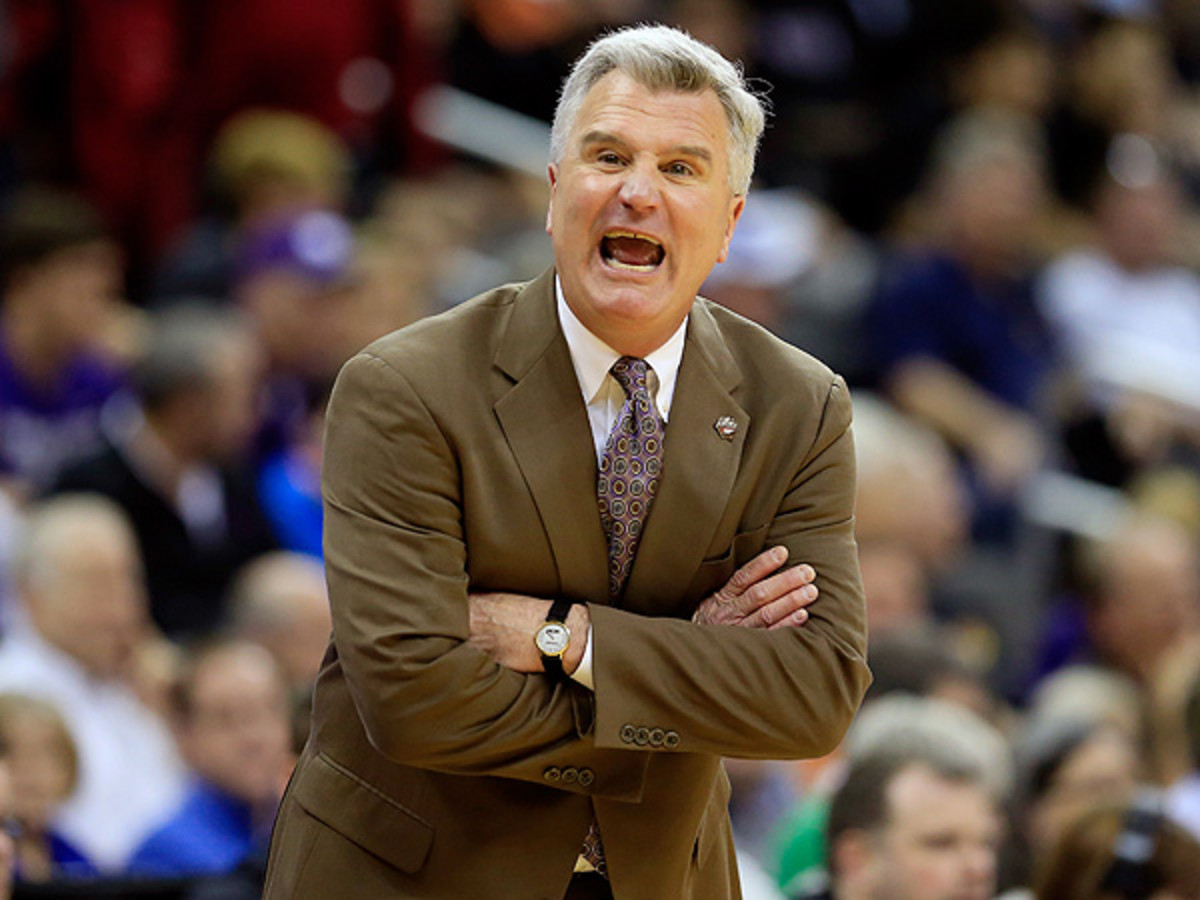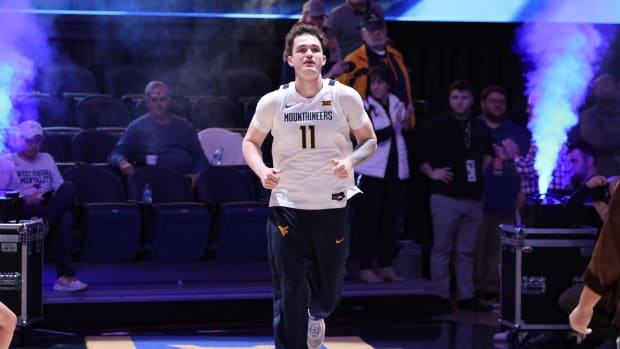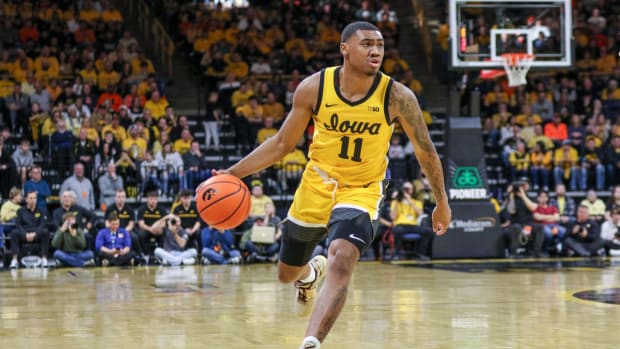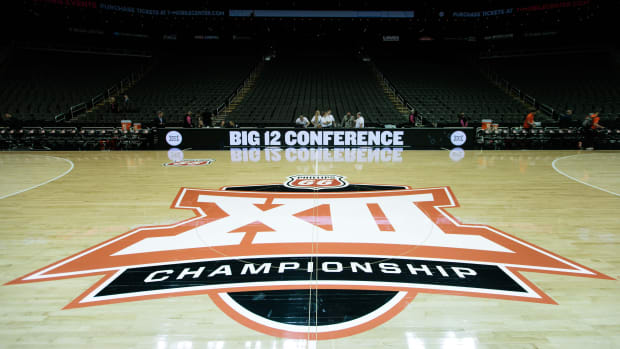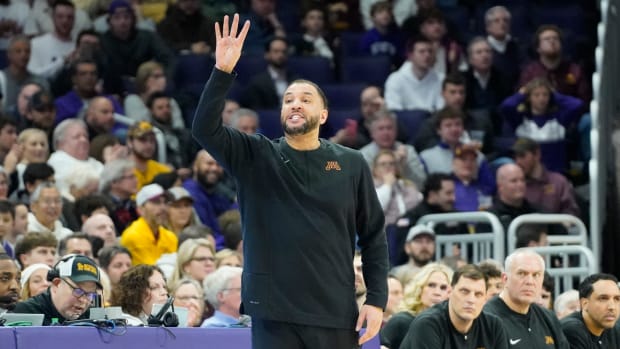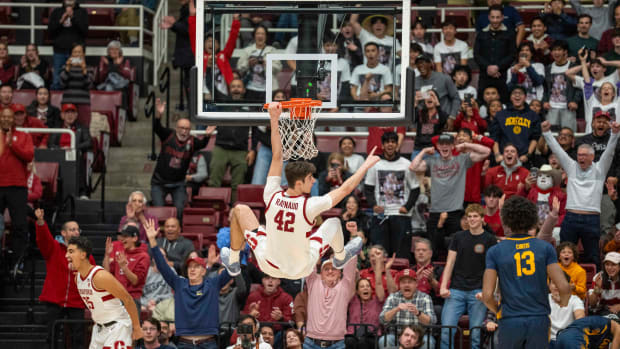Stock Watch Big 12: Oklahoma State poised to challenge Kansas; Kansas State taking a step back
Will Bruce Weber struggle once again with winning with his own recruits this season at Kansas State? (Jamie Squire/Getty Images)
Over the next few weeks, One and One will highlight two teams from each conference -- one riding a positive trajectory heading into the 2013-14 season (stock up) and one headed for a decline (stock down). The unpredictability of college basketball could force a reassessment of these projections at some point over the next few months, but whether our analysis is prescient or misguided, watching the following teams perform in the upcoming season should be fascinating.
Stock up: Oklahoma State
On April 17, Oklahoma State looked like the best team in the Big 12.
Sophomore point guard Marcus Smart had announced he would return to school for at least one more season. Second and third-leading scorers Markel Brown and Le’Bryan Nash said they would join him.
Their decisions changed the outlook of the 2013-14 conference championship race: The Cowboys, with Smart, Nash and Brown back, along with a slew of complementary pieces, had the talent necessary to bring an end to Kansas’ nine-year stranglehold over the top of the Big 12. That was the prevailing notion at the time, and it felt downright reasonable. Oklahoma State was better than Kansas. There was a strong possibility, it seemed, that someone not named Bill Self would claim sole possession of the Big 12 regular season championship trophy for the first time since 2004.
About a month later, Oklahoma State’s case as the Big 12’s preseason frontrunner looked far less convincing. Andrew Wiggins, the No. 1-ranked prospect in the class of 2013, ended one of the most unpredictable, high-profile recruitments in recent memory when he chose Kansas over Kentucky, Florida State and North Carolina. Days later, the Jayhawks announced the addition of highly-coveted Memphis graduate transfer Tarik Black.
Those additions left Oklahoma State, and the rest of the Big 12, in a familiar position. The Jayhawks had suddenly emerged as the favorites to win the conference; another regular season championship would follow, it was believed. As the hype surrounding Wiggins was amplified to ridiculous proportions, Kansas’ place atop the preseason Big 12 pecking order seemed even more entrenched.
It would be up to Oklahoma State to dethrone the Jayhawks.
Even if that doesn’t happen, this year’s Oklahoma State team appears to be the best one Travis Ford has coached since arriving in Stillwater in 2008. Smart, Brown and junior Brian Williams form one of the best perimeter trios in the country, while sharp-shooting sophomore Phil Forte and freshman Stevie Clarke should contribute off the bench. Nash and junior forward Michael Cobbins, who was named to the Big 12’s All-Defensive team last season after posting an impressive 6.6 block percentage, according to Kenpom.com, make up the Cowboys’ probable starting frontcourt duo.
There are few (if any) starting fives in the Big 12 that can match Oklahoma State’s, man-for-man, but the Cowboys could use some more depth in the frontcourt. Sophomore Kamari Murphy has promise, and junior Gary Gaskins is one of the team's best all-around athletes. How much one or both can help Oklahoma State this season is an open question.
All things considered, the Cowboys appear to have what it takes to challenge Kansas for a league championship. The Jayhawks may be more talented, but Oklahoma State is more experienced, brings back arguably the best returning player in college basketball (Smart) and proved as recent as last season that it can beat Kansas (OSU ended the Jayhawks’ 33-game winning streak at Allen Fieldhouse with a five-point win on Feb. 2).
Whoever comes out on top, watching Oklahoma State and Kansas push one another in a heated league title race should be one of the more fascinating storylines of the upcoming season.
Stock down: Kansas State
When Illinois fired Bruce Weber at the end of the 2011-12 season, those in favor of the move pointed out that Weber’s early success at the school came thanks to players recruited by former Illini (and now Kansas) coach Bill Self. That may be a fair criticism, but it doesn’t amount to a comprehensive explanation for why Weber was dismissed after nine relatively successful seasons in Champaign. Barring a surprise, that same basic premise -- Weber succeeding with a former coach’s recruits, then failing to win as consistently with his own -- could resurface as a talking point in the near future.
Kansas State won a share of the Big 12 regular season championship in 2012-13, Weber’s first season at the school, with a roster populated by former coach Frank Martin's recruits. But the Wildcats -- who lost leading scorer Rodney McGruder, guard Martavious Irving and forward Jordan Henriquez to graduation, along with point guard Angel Rodriguez to transfer, this offseason -- are all but guaranteed to take a step back in 2013-14. Many of Martin’s players remain, so it will be impossible to know for a few years whether Weber can succeed with a roster composed entirely of his own recruits. But don’t be surprised if questions about Weber’s long-term viability as a winning coach arise as early as this season.
That’s a long-term concern. In 2013-14, Kansas State has some major questions to answer. First, who will replace McGruder as the Wildcats’ primary scoring option? How will senior Will Spradling handle the playmaking responsibilities demanded at point guard, after spending most of his college career at shooting guard?
The answer to the first question could be Shane Southwell, a 6-6 senior who posted a 114.1 offensive rating and 55.7 effective field goal percentage while playing 61.0 percent of available minutes last season, according to Kenpom.com. If Southwell can continue to score efficiently while increasing the number of shots he takes, the loss of McGruder might not be as damaging as most believe it will be. Spradling has played point guard at Kansas State before, and he probably won’t need to handle the position on a full-time basis the entire season, as three-star freshman Jevon Thomas should enter the rotation once he becomes eligible in December (fellow freshmen Nigel Johnson and Marcus Foster could also earn playing time in the backcourt).
Junior Thomas Gipson, who averaged 7.9 points in 18.7 minutes per game, should anchor the frontcourt, with undersized junior Nino Williams contributing and sophomore D.J. Johnson providing a shot-blocking presence. Freshman forward Wesley Iwundu could be used in a reserve role.
It’s hard to believe this team, after losing a number of key players to transfer and graduation, can make another run at a league championship. Kansas and Oklahoma State seem a cut above the rest in this conference. The Wildcats will likely aim for more modest goals, like reaching their fifth consecutive NCAA tournament, or making important developmental strides with a batch of new players.
